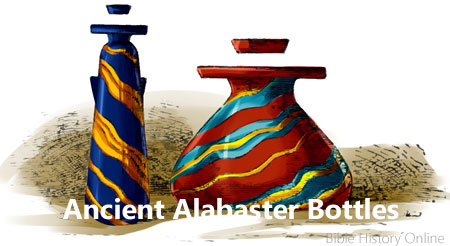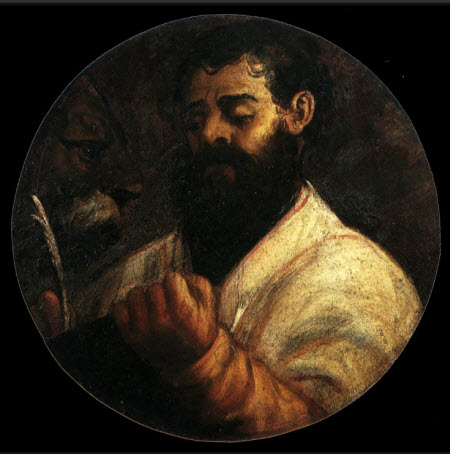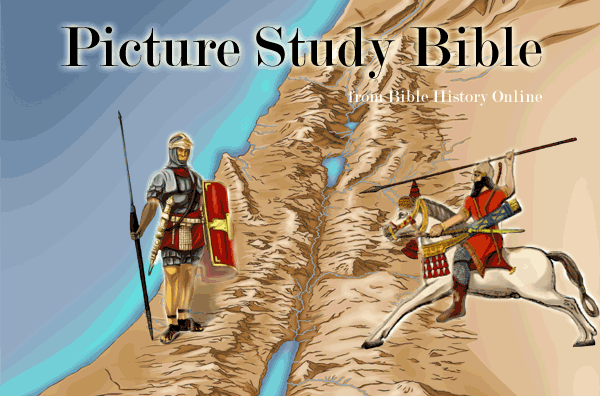Mark 14:54 And Peter followed him afar off, even into the palace of the high priest: and he sat with the servants, and warmed himself at the fire. - Free Bible Online
Mark 14:54 And Peter had followed Him at a distance, right into the courtyard of the high priest; and he was sitting with the officers, and warming himself at the fire.
54. And Peter followed him afar off, even into--or "from afar, even
to the interior of."
the palace of the high priest--"An oriental house," says
ROBINSON,
"is usually built around a quadrangular interior court; into which there
is a passage (sometimes arched) through the front part of the house,
closed next the street by a heavy folding gate, with a smaller wicket
for single persons, kept by a porter. The interior court, often paved or
flagged, and open to the sky, is the hall, which our translators
have rendered 'palace,' where the attendants made a fire; and the
passage beneath the front of the house, from the street to this court,
is the porch. The place where Jesus stood before the high priest
may have been an open room, or place of audience on the ground floor, in
the rear or on one side of the court; such rooms, open in front, being
customary. It was close upon the court, for Jesus heard all that was
going on around the fire, and turned and looked upon Peter
(Lu 22:61)."
and he sat with the servants, and warmed himself at the fire--The
graphic details, here omitted, are supplied in the other Gospels.
Joh 18:18:
And the servants and officers stood there--that is, in the hall,
within the quadrangle, open to the sky.
who had made a fire of coals--or charcoal (in a brazier probably).
for it was cold--John alone of all the Evangelists mentions the
material, and the coldness of the night, as WEBSTER and
WILKINSON remark. The elevated situation of Jerusalem, observes
THOLUCK,
renders it so cold about Easter as to make a watch fire at night
indispensable.
And Peter stood with them and warmed himself--"He went
in," says Matthew
(Mt 26:58),
"and sat with the servants to see the end." These two minute
statements throw an interesting light on each other. His wishing to
"see the end," or issue of these proceedings, was what led him into the
palace, for he evidently feared the worst. But once in, the serpent
coil is drawn closer; it is a cold night, and why should not he take
advantage of the fire as well as others? Besides, in the talk of the
crowd about the all-engrossing topic he may pick up something which he
would like to hear. Poor Peter! But now, let us leave him warming
himself at the fire, and listening to the hum of talk about this
strange case by which the subordinate officials, passing to and fro and
crowding around the fire in this open court, would while away the time;
and, following what appears the order of the Evangelical Narrative, let
us turn to Peter's Lord.
Jesus Is Interrogated by Annas--His Dignified Reply--Is Treated with Indignity by One of the Officials--His Meek Rebuke (Joh 18:19-23).
We have seen that it is only the Fourth Evangelist who tells us that our Lord was sent to Annas first, overnight, until the Sanhedrim could be got together at earliest dawn. We have now, in the same Gospel, the deeply instructive scene that passed during this non-official interview.
Joh 18:19:
The high priest--Annas.
then asked Jesus of His disciples and of His doctrine--probably to entrap Him into some statements which might be used against Him at the trial. From our Lord's answer it would seem that "His disciples" were understood to be some secret party.Joh 18:20.
Jesus answered him, I spake openly to the world--compare Joh 7:4. He speaks of His public teaching as now a past thing--as now all over.
I ever taught in the synagogue and in the temple, whither the Jews always resort--courting publicity, though with sublime noiselessness.
and in secret have I said nothing--rather, "spake I nothing"; that is, nothing different from what He taught in public: all His private communications with the Twelve being but explanations and developments of His public teaching. (Compare Isa 45:19; 48:16).Joh 18:21:
Why askest thou Me? ask them which heard Me what I have said to them--rather, "what I said unto them."
behold, they know what I said--From this mode of replying, it is evident that our Lord saw the attempt to draw Him into self-crimination, and resented it by falling back upon the right of every accused party to have some charge laid against Him by competent witnesses.Joh 18:22:
And when He had thus spoken, one of the officers which stood by struck Jesus with the palm of his hand, saying, Answerest Thou the high priest so?--(see Isa 50:6). It would seem from Ac 23:2 that this summary and undignified way of punishment what was deemed insolence in the accused had the sanction even of the high priests themselves.Joh 18:23:
Jesus answered him, If I have spoken evil--rather, "If I spoke evil," in reply to the high priest.
bear witness of the evil; but if well, why smitest thou Me?--He does not say "if not evil," as if His reply had been merely unobjectionable; but "if well," which seems to challenge something altogether fitting in the remonstrance. He had addressed to the high priest. From our Lord's procedure here, by the way, it is evident enough that His own precept in the Sermon on the Mount--that when smitten on the one cheek we are to turn to the smiter the other also (Mt 5:39) --is not to be taken to the letter.Annas Sends Jesus to Caiaphas (Joh 18:24).
Joh 18:24.
Now Annas had sent Him bound unto Caiaphas the high priest--On the meaning of this verse there is much diversity of opinion; and according as we understand it will be the conclusion we come to, whether there was but one hearing of our Lord before Annas and Caiaphas together, or whether, according to the view we have given above, there were two hearings--a preliminary and informal one before Annas, and a formal and official one before Caiaphas and the Sanhedrim. If our translators have given the right sense of the verse, there was but one hearing before Caiaphas; and then Joh 18:24 is to be read as a parenthesis, merely supplementing what was said in Joh 18:13. This is the view of CALVIN, BEZA, GROTIUS, BENGEL, DE WETTE, MEYER, LUCKE, THOLUCK. But there are decided objections to this view. First: We cannot but think that the natural sense of the whole passage, embracing Joh 18:13, 14, 19-24, is that of a preliminary non-official hearing before "Annas first," the particulars of which are accordingly recorded; and then of a transference of our Lord from Annas to Caiaphas. Second: On the other view, it is not easy to see why the Evangelist should not have inserted Joh 18:24 immediately after Joh 18:13; or rather, how he could well have done otherwise. As it stands, it is not only quite out of its proper place, but comes in most perplexingly. Whereas, if we take it as a simple statement of fact, that after Annas had finished his interview with Jesus, as recorded in Joh 18:19-23, he transferred Him to Caiaphas to be formally tried, all is clear and natural. Third: The pluperfect sense "had sent" is in the translation only; the sense of the original word being simply "sent." And though there are cases where the aorist here used has the sense of an English pluperfect, this sense is not to be put upon it unless it be obvious and indisputable. Here that is so far from being the case, that the pluperfect "had sent" is rather an unwarrantable interpretation than a simple translation of the word; informing the reader that, according to the view of our translators, our Lord "had been" sent to Caiaphas before the interview just recorded by the Evangelist; whereas, if we translate the verse literally--"Annas sent Him bound unto Caiaphas the high priest"--we get just the information we expect, that Annas, having merely "precognosced" the prisoner, hoping to draw something out of Him, "sent Him to Caiaphas" to be formally tried before the proper tribunal. This is the view of CHRYSOSTOM and AUGUSTINE among the Fathers; and of the moderns, of OLSHAUSEN, SCHLEIERMACHER, NEANDER, EBRARD, WIESELER, LANGE, LUTHARDT. This brings us back to the text of our second Gospel, and in it to
JFB.
Questions Related to this Verse
Where in Scripture does it say that Jesus was against the religious traditions of washing?Select a Chapter
-
Mark 1 |
Mark 2 |
Mark 3 |
Mark 4 |
Mark 5 |
Mark 6 |
Mark 7 |
Mark 8 |
Mark 9 |
Mark 10 |
Mark 11 |
Mark 12 |
Mark 13 |
Mark 14 |
Mark 15 |
Mark 16 |
Select a Book of the Bible
-
Genesis |
Exodus |
Leviticus |
Numbers |
Deuteronomy |
Joshua |
Judges |
Ruth |
1 Samuel |
2 Samuel |
1 Kings |
2 Kings |
1 Chronicles |
2 Chronicles |
Ezra |
Nehemiah |
Esther |
Job |
Psalms |
Proverbs |
Ecclesiastes |
Song of Solomon |
Isaiah |
Jeremiah |
Lamentations |
Ezekiel |
Daniel |
Hosea |
Joel |
Amos |
Obadiah |
Jonah |
Micah |
Nahum |
Habakkuk |
Zephaniah |
Haggai |
Zechariah |
Malachi |
Matthew |
Mark |
Luke |
John |
Acts |
Romans |
1 Corinthians |
2 Corinthians |
Galatians |
Ephesians |
Philippians |
Colossians |
1 Thessalonians |
2 Thessalonians |
1 Timothy |
2 Timothy |
Titus |
Philemon |
Hebrews |
James |
1 Peter |
2 Peter |
1 John |
2 John |
3 John |
Jude |
Revelation |
Brief Summary: Christ anointed at Bethany. (1-11) The Passover, Jesus declares that Judas would betray him. (12-21) The Lord's supper instituted. (22-31) Christ's agony in the garden. (32-42) He is betrayed and taken. (43-52) Christ before the high priest. (53-65) Peter denies Christ. (66-72)

Alabaster bottles from the ancient
world
Mark 14:3 - And being in Bethany in the house of Simon the leper, as he sat at meat, there came a woman having an alabaster box of ointment of spikenard very precious; and she brake the box, and poured [it] on his head.
The Book of Mark
Mark 1:15 - And saying, The time is fulfilled, and the kingdom of God is at hand: repent ye, and believe the gospel.
Mark 2:12 - And immediately he arose, took up the bed, and went forth before them all; insomuch that they were all amazed, and glorified God, saying, We never saw it on this fashion.
Mark in The New Testament - A Brief Overview

Painting of St. Mark by Titian - 1560
Introduction to The Gospel of Mark
The Word Gospel. The second book of the English Bible that most of us read from is the Gospel of Mark. Mark is the second of the four gospel writings, yet there is only one gospel about Jesus Christ and there are four different writers: Matthew, Mark, Luke, and John. The word "Gospel" means "good news", and the good news is about Jesus Christ dying on the cross and then 3 days later conquering death and rising from the dead, offering salvation to all mankind, this is the Gospel.
Summary of The Book of Mark
Brief Summary. Jesus of Nazareth is the suffering servant who came to die for the sins of all men. He did His work and "immediately" went to the cross, so be encouraged all who are suffering because Christ suffered for you.
Purpose. The Book of Mark is the shortest of the 4 Gospel accounts of the life of Jesus Christ. and he seems to write his account of the Gospel of Christ with a sense of urgency. He mentions the word "immediately" 27 times. In Mark many times Jesus exercises actions rather than words, which would impress his Roman readers who the Book seems to be addressing. He portrays Jesus as a man of power and miracles, who could set aside the laws of nature at will. Yet this powerful Son of God was the suffering servant who would give up His life as a ransom for all mankind (Mark 10:45). The clear purpose of mark was to encourage those suffering persecution that their master suffered first, and He suffered for them.
Audience. Apparently Mark wrote his Gospel account to encourage gentile Christians in Rome who were facing the persecutions of the Emperor Nero. History is clear about the atrocious behavior of the Romans and especially the insanity of Nero. The other evidence that scholars bring up concerning mark's audience as being gentiles is the fact that Mark does not deal with Jewish Laws and he only quotes one prophecy from the Old Testament. There is also careful thought into explaining Jewish customs and idioms. (See Mark 3:7; 5:41; 7:2; 10:46; 14:36; 15:34; 9:43; 14:12; 15:42).
Authorship. The gospel of Mark does not proclaim who the author is within the document, yet the information that we know about Mark can be seen in the writer of this gospel. It is evident that the writer was Jewish, he was a Christian, and he was familiar with every day Jewish life, as well as the Jewish Scriptures. We know from the Scriptures that Mark was Jewish, and he knew the teachings of Jesus very well. He also knew the teachings of the rest of the apostles. It is also important to notice that after Peter was imprisoned he went to the house of Mary, the mother of Mark (Acts 12:12-17). Also Peter mentions in his epistle "my son Mark" (1 Peter 5:13). During Paul's missionary journeys Mark became a companion of Paul and Barnabas, and he left them at Perga in Pamphylia (Acts 13:13), after Paul had rebuked him. Many years later Mark regained the favor of Paul (Col. 4:10; 2 Tim. 4:11). Early Church tradition unanimously ascribes the second gospel to Mark as a companion of Peter and the writer of the second Gospel. One prologue to the Gospels which was written around 160 AD has this statement: "Mark� Was Peter's interpreter, and after Peter's decease wrote down this gospel in the region of Italy." Irenaeus, Clement of Alexandria and Tertullian also attest to Mark as the author.
Location. Nothing in the Gospel of Mark indicates where it was written from. Most of the early writers who boast of Mark as the author also name Rome as the place it was written.
Date. Early Christian writers and traditions place the Gospel of Mark sometime close to the end of Peter's life, around 60-65 AD. Most scholars agree that the Gospel of Mark was written before the destruction of Jerusalem in 70 AD, while the Second Temple in Jerusalem was still standing (Mark 13:1-2). Many scholars do not believe in the miracle of predictive prophecy and argue that the Gospel of Mark was written after the fall of Jerusalem, because of the accurate details of the events that Jesus spoke about. Mark's Gospel account seems to have been written as encouragement to the Christians who were facing the persecution of the Emperor Nero which took place in 64 AD.
Outline of the Book of Mark
The Servant Comes - Chapter 1:1-13
The Servant's Work - Chapters 1:14-13:37
The Servant's Death - Chapters 14:1-15:47
The Servant's Resurrection - Chapter 16:1-20

The Name Jesus In Ancient Hebrew Text
"Yeshua" in First Century Hebrew Text. This is how the name "Jesus"
would have been written in ancient Hebrew documents. The four letters or
consonants from right to left are Yod, Shin, Vav, Ayin (Y, SH, OO, A).
Jesus is the Greek name for the Hebrew name Joshua or Y'shua which means
"The LORD or Yahweh is Salvation".
Mark Resources
Outline of the Life of Jesus in Harmony
Simple Map of First Century Israel
Topographical Map of First Century Israel
Map of the Ministry of
Jesus
Map of the Roads in Ancient Israel
Map of the Roman Empire
Bibliography Information
Free Bible Online Picture Study Bible, King James Version. New York: American Bible Society: www.free-bible.com, 1995-2013. Bible History Picture Study Bible. May 11, 2024.
- King James Bible Home
- Free Bible Home Page
- Bible Encyclopedia (ISBE)
- Online Bible (KJV)
- Naves Topical Bible
- Smith's Bible Dictionary
- Easton's Bible Dictionary
- Fausset's Bible Dictionary
- Matthew Henry Bible Commentary
- Hitchcock's Bible Dictionary
Read The Bible
- 1599 Geneva Bible (GNV)
- 21st Century King James Version (KJ21)
- American Standard Version (ASV)
- Amplified Bible (AMP)
- Amplified Bible, Classic Edition (AMPC)
- Authorized (King James) Version (AKJV)
- BRG Bible (BRG)
- Christian Standard Bible (CSB)
- Common English Bible (CEB)
- Complete Jewish Bible (CJB)
- Contemporary English Version (CEV)
- Darby Translation (DARBY)
- Disciples’ Literal New Testament (DLNT)
- Douay-Rheims 1899 American Edition (DRA)
- Easy-to-Read Version (ERV)
- English Standard Version (ESV)
- English Standard Version Anglicised (ESVUK)
- Evangelical Heritage Version (EHV)
- Expanded Bible (EXB)
- GOD’S WORD Translation (GW)
- Good News Translation (GNT)
- Holman Christian Standard Bible (HCSB)
- International Children’s Bible (ICB)
- International Standard Version (ISV)
- J.B. Phillips New Testament (PHILLIPS)
- Jubilee Bible 2000 (JUB)
- King James Version (KJV)
- Lexham English Bible (LEB)
- Living Bible (TLB)
- Modern English Version (MEV)
- Mounce Reverse Interlinear New Testament (MOUNCE)
- Names of God Bible (NOG)
- New American Bible (Revised Edition) (NABRE)
- New American Standard Bible (NASB)
- New American Standard Bible 1995 (NASB1995)
- New Catholic Bible (NCB)
- New Century Version (NCV)
- New English Translation (NET)
- New International Reader's Version (NIRV)
- New International Version - UK (NIVUK)
- New International Version (NIV)
- New King James Version (NKJV)
- New Life Version (NLV)
- New Living Translation (NLT)
- New Matthew Bible (NMB)
- New Revised Standard Version (NRSV)
- New Revised Standard Version Catholic Edition (NRSVCE)
- New Revised Standard Version, Anglicised (NRSVA)
- New Revised Standard Version, Anglicised Catholic Edition (NRSVACE)
- New Testament for Everyone (NTE)
- Orthodox Jewish Bible (OJB)
- Revised Geneva Translation (RGT)
- Revised Standard Version (RSV)
- Revised Standard Version Catholic Edition (RSVCE)
- The Message (MSG)
- The Voice (VOICE)
- Tree of Life Version (TLV)
- World English Bible (WEB)
- Worldwide English (New Testament) (WE)
- Wycliffe Bible (WYC)
- Young's Literal Translation (YLT)
Table of Contents
Main Menu
- Ancient Assyrian Social Structure
- Ancient Babylonia
- Ancient Canaan During the Time of Joshua
- Ancient History Timeline
- Ancient Oil Lamps
- Antonia Fortress
- Archaeology of Ancient Assyria
- Assyria and Bible Prophecy
- Augustus Caesar
- Background Bible Study
- Bible
- Biblical Geography
- Fallen Empires - Archaeological Discoveries and the Bible
- First Century Jerusalem
- Glossary of Latin Words
- Herod Agrippa I
- Herod Antipas
- Herod the Great
- Herod's Temple
- High Priest's in New Testament Times
- Jewish Literature in New Testament Times
- Library collection
- Map of David's Kingdom
- Map of the Divided Kingdom - Israel and Judah
- Map of the Ministry of Jesus
- Matthew Henry Bible Commentary
- Messianic Prophecy
- Nero Caesar Emperor
- Online Bible Maps
- Paul's First Missionary Journey
- Paul's Second Missionary Journey
- Paul's Third Missionary Journey
- Pontius Pilate
- Questions About the Ancient World
- Tabernacle of Ancient Israel
- Tax Collectors in New Testament Times
- The Babylonian Captivity
- The Black Obelisk of Shalmaneser
- The Books of the New Testament
- The Court of the Gentiles
- The Court of the Women in the Temple
- The Destruction of Israel
- The Fall of Judah with Map
- The History Of Rome
- The Incredible Bible
- The Jewish Calendar in Ancient Hebrew History
- The Life of Jesus in Chronological Order
- The Life of Jesus in Harmony
- The Names of God
- The New Testament
- The Old Testament
- The Passion of the Christ
- The Pharisees
- The Sacred Year of Israel in New Testament Times
- The Samaritans
- The Scribes
Ancient Questions
- How did the ancient Greeks and Romans practice medicine and treat illnesses?
- What were the major contributions of ancient Babylon to mathematics and astronomy?
- How did the ancient Persians create and administer their vast empire?
- What were the cultural and artistic achievements of ancient India, particularly during the Gupta Empire?
- How did ancient civilizations like the Incas and Aztecs build their remarkable cities and structures?
- What were the major trade routes and trading practices of the ancient world?
- What was the role of slavery in ancient societies like Rome and Greece?
- How did the ancient Mayans develop their sophisticated calendar system?
- What were the key events and significance of the Battle of Thermopylae in ancient Greece?
- What was life like for women in ancient Rome?
Bible Study Questions
- What does biblical archaeologist said about hieroglyphics?
- Where is the Negev where Abram went to in Genesis?
- What is the name of Ramallah in the Bible?
- How do we approach and study the historical and cultural context of biblical passages?
- What is the significance of the Psalms in personal and corporate worship?
- How do we discern and apply biblical principles to contemporary ethical issues?
- What is the biblical perspective on the nature of God's love and mercy?
- How do we interpret and understand apocalyptic literature in the Bible?
- What are the different covenants in the Bible and their significance?
- How do we grow in spiritual maturity and develop a deeper understanding of the Word?
About
Welcome to Free Bible: Unearthing the Past, Illuminating the Present! Step into a world where ancient history and biblical narratives intertwine, inviting you to explore the rich tapestry of human civilization.
Discover the captivating stories of forgotten empires, delve into the customs and cultures of our ancestors, and witness the remarkable findings unearthed by dedicated archaeologists.
Immerse yourself in a treasure trove of knowledge, where the past comes alive and illuminates our understanding of the present.
Join us on this extraordinary journey through time, where curiosity is rewarded and ancient mysteries await your exploration.
Recent posts
-

Personalized Baby Bibs for every Little
Every little one deserves to feel cherished and celebrated from the very start. These custom baby bibs, lovingly personalized with care, make the perf... -

The Art of Custom Home Design: Unveiling Wellcore Corporation's Expertise
In the ever-evolving panorama of contemporary production, customization reigns ultimate as a testament to innovation and the preference for a without ... -

Birthstones: A Sparkling Symphony of History, Symbolism, and Self-Expression
Birthstones, the ones fascinating gems linked to our delivery month, boast a records as rich and multifaceted because the jewels themselves. Their tal... -

The use of medicinal mushrooms by different religions of the world.
The integration of medicinal mushrooms into various religious practices around the world is a fascinating testament to their revered status across cul... -

Explore a Collection of Religious SVGs
Religious SVGs are versatile design elements that can be used to create a variety of personalized and meaningful projects. Whether you're looking to e...
